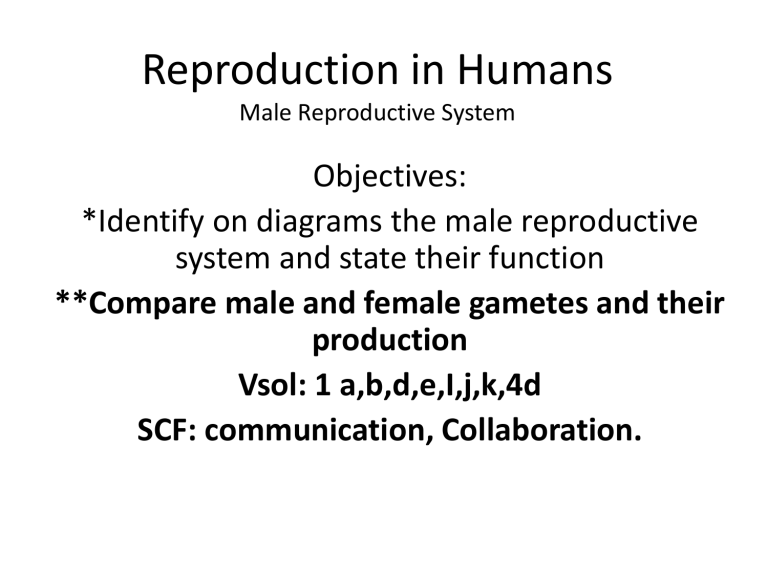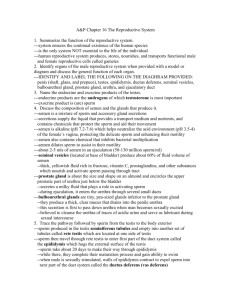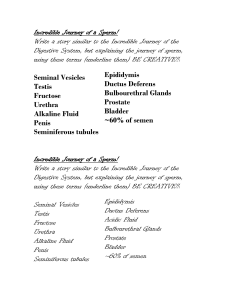
Reproduction in Humans Male Reproductive System Objectives: *Identify on diagrams the male reproductive system and state their function **Compare male and female gametes and their production Vsol: 1 a,b,d,e,I,j,k,4d SCF: communication, Collaboration. scrotum Organ Testes Functions Function Scrotum Produce spermatozoa and make male hormone testosterone which stimulates changes during puberty Sac covering testes which hangs outside the body to keep it cool as sperm can’t develop or be stored at 37 0C or above Sperm duct Small tubules outside the testes store sperms for maturation. Sperm duct connect these tubules to urethra urethra Urethra carries urine and sperm but not at the same time. A ring of muscle around the urethra contracts to prevent urine loss during sexual intercourse Prostate and other glands Secrete fluid for sperm cell to swim. Prostate secrete mucus and other secrete sugar for respiration of sperm cells. Sperm cell + fluid = semen Penis Urethra runs down the centre of penis. Its main function is to deliver sperm to the vagina for fertilization Gametes (sex cells) Acrosome (contain enzymes to break the jelly coat Cell membrane nucleus Head Middle piece (Has mitochondria to power swimming by the tail) Jelly coat Egg cell cytoplasm Drives sperm forward Sperms and eggs are specialised. Which statements belong to a sperm and which to eggs? Compare Feature Sperm cell Egg cell Much larger size small movement Swim using tail that lashes from side to side Does not move itself . Moved along oviduct by cilia and peristalsis food store Has very little – uses sugar in seminal fluid for respiration Protein and fat in cytoplasm- enough to last till implantation in uterus no. of chromosomes 23 (haploid) 23 (haploid) number produced Millions produced constantly after puberty often throughout life One a month after puberty until menopause except when pregnant or taking contraceptive pills Female Reproductive System Objectives: * Identify on diagrams the female reproductive system and state their function **Describe sexual intercourse in humans Functions Organ Function Ovaries(attached to inside of abdomen just below the kidneys releasing 1 ova /28days alternately Produce ova and make female hormones progesterone and oestrogen which stimulates changes during puberty. Oestrogen- development of sex organs and sec. sexual characteristics progesterone prepares uterus for receiving the embryo in case of pregnancy oviduct The egg passes out to the funnel shaped opening of the oviduct in a process called ovulation which then either gets fertilised by a sperm or die after passing into the uterus Foetus develops here. It develops a spongy wall for implantation of the embryo in case of pregnancy A ring of muscles at the lower end of the uterus leading to vagina A muscular tube opening outside the body Uterus cervix Vagina urethra A separate opening above the vaginal opening for urination clitoris Above urethra a very sensitive area (lot of nerves) vulva Outer opening of vagina Word Check 18-9-16 Spermatogenesis To be able to understand the process of sperm production. Standard: VSoL: 1 a,b,d,e,4 d SCF: Communication , Collaboration, Critical Thinking SPERMATOGENESIS • Definition: It is the different steps by which spermatogonia are transformed into spermatozoa in the testis. It begins at puberty (13-16 years) and continues into old age. The whole process takes about 64 days. Starter • Review: Fill in the blanks. • VSOL 4 d • Competency -- communication & team work Answers • • • • • • • • • • • Testes Semen Seminal vesicles Bulbourethral glands Prostrate glands Urethra Penis Ovary/ovaries Oviducts/fallopian tube Uterus fertilization Site of sperm formation Seminiferous tubules of Testis MALE REPRODUCTIVE SYSTEM TESTIS MALE REPRODUCTIVE SYSTEM TESTIS EPIDIDYMIS LOBULES TUNICA ALBUGINEA TESTIS H&E SEMINIFEROUS TUBULES TESTIS H&E SEMINIFEROUS TUBULES SEMINIFEROUS TUBULES INTERSTITIAL CONN. TISSUE TESTIS H&E SEMINIFEROUS TUBULES SEMINIFEROUS TUBULES INTERSTITIAL CONN. TISSUE MALE REPRODUCTIVE SYSTEM MALE REPRODUCTIVE SYSTEM SPERMATOGENESIS SPERMATOGONIA 1º SPERMATOCYTE 2º SPERMATOCYTE SPERMATIDS 2º SPERMATOCYTE 1º SPERMATOCYTE SERTOLI CELLS SPERMATOGONIA SPERMATIDS MALE REPRODUCTIVE SYSTEM SPERMIOGENESIS Mature sperm 60µm long and acquire full motility in epididymis (1) HEAD - nucleus and acrosome (2) NECK - centriole and connecting piece (3) TAIL - middle piece MALE REPRODUCTIVE SYSTEM SPERMIOGENESIS EPIDIDYMIS EFFERENT DUCTULES EFFERENT DUCTULES EPIDIDYMIS EFFERENT DUCTULES EPIDIDYMIS EPIDIDYMIS 2n spermatogonium growth mitosis primary spermatocyte Seminiferous 2n tubules Meiosis I secondary n n spermatocyte Meiosis II spermatids n n differentiation (Sertoli cells provide nutrients) n n sperm cells (spermatozoa) n n n n Cross-section of seminiferous tubules Sertoli cell nucleus germinal epithelium Oogenesis (Intro’) • Formation of eggs • Outer layer of ovaries multiply to form oogonia • Oogonia grow and mature into oocytes • Oocytes divide by meiosis to produce haploid gametes Oogenesis • The process of egg formation starts before birth • The outer layer of the ovary, the germinal epithelium, produces many oogonia • Oogonia grow to form primary oocytes (2n) • It also produces follicle cells • multiply and cluster around the oocytes • forming primary follicles primary follicle secondary follicle 2n n Stages in the development of one follicle in a human ovary Mitosis Maturation Meiosis Growth Male Mitosis and (spermatogenesis) cell division Further divisions Spermatogonia Many cells Primary spermatocyte Growth (2n) Secondary spermatocyte (n) Spermatids (n) Female (oogenesis) Oogonia Primary oocyte (2n) of chromosome DevelopmentHalving of follicle number from diploid (2n) to haploid (n) Released during First polar body (n) ovulation fertilisationSecondary oocyte (n) Second polar body (n) First polar body (n) Egg (n) Sperm (n) Gametogenesis in male and female The primary oocyte continues the first meiotic division leading to two unequal daughter cells with 23 chromosomes each (22 autosomes + X). The large cell is called the secondary oocyte and the small one (having little cytoplasm) is the first polar body. The secondary oocyte and the first polar body enter the second meiotic division without DNA replication. - The second meiotic division is completed only if fertilization occurs to give fertilized oocyte (mature ovum) and a second polar body that soon degenerates.




